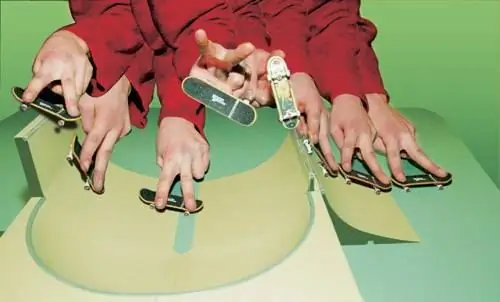Every fingerboard owner wants to learn a variety of tricks that can be performed on no worse than on a real skateboard. However, most tricks are impossible to perform if you do not have special tools for this - in particular, a finger park, which allows you to learn a whole range of new complex tricks, and which can be easily made by hand at home.

Instructions
Step 1
The most affordable materials for the park are wood, fiberboard, chipboard and plywood, as these materials are low cost and easy to process. One of the main elements of the park is a fan box, and to make it you will need a sheet of fiberboard, as well as wire, furniture corners, pieces of wood, PVA wood glue and tools - a hammer, screwdriver, jigsaw, self-tapping screws, drill, square, pencil and much other.
Step 2
Use a jigsaw to cut two fan-box racks from the pieces of wood. Select the width of the racks as you wish. Then take a sheet of fiberboard, the width of which corresponds to the width of the racks. Saw the sheet into four parts. The length of one of them should correspond to the length of the upper part of the fan-box, you use two small parts as races, and set the third part as the basis of the structure.
Step 3
Having assembled the structure of fiberboard and wooden racks, grind all surfaces and joints of the plates with a grinder and sandpaper.
Step 4
Cut a piece of the desired length from the coil of wire for the railings, taking into account the angle of their rise above the surface and the areas of attachment to the wood bars. Drill two holes in the racks with a thin drill and install the ends of the wire in them, after dropping PVA glue into the holes.
Step 5
Railings provide new opportunities for mastering tricks - therefore, another element of the finger park can be a staircase with railings for jumping and sliding. To make a ladder, you will also need fiberboard or plywood, pieces of wood for the base, wire for the handrail, and boxes of audio cassettes or CDs for the steps.
Step 6
Form a ladder from several empty boxes from discs or cassettes and tape them so that the structure is held tight. After that, from fiberboard or plywood, cut out the lower and upper parts of the frame to which you will attach the steps. From the blocks of wood, cut out racks equal to the height of the stairs.
Step 7
Cut a piece of thick enough wire and fold it into a railing. Then drill two holes at the very bottom and at the very top of the stairs, fill them with glue and install the two ends of the wire railing in them.
Step 8
It is difficult to imagine a fingerpark without a ramp - it should also become its obligatory element, since most of the tricks are performed on the ramp. Cut a rectangle out of plywood or fiberboard, equal to the length and width of the future ramp, and place it in hot water for a few minutes.
Step 9
Then carefully fold the dampened sheet around the cylindrical object, then tie the folded sheet with a string, remove the cylindrical base and leave the sheet to dry, laying it with its edges down on a flat surface and pressing with a heavy object.
Step 10
Make ramp supports from wooden blocks that are attached to the canvas with furniture corners after it is completely dry.
Step 11
Separately cut two small areas that you will reinforce at the edges of the ramp - from these areas the fingerboard will slide into the ramp. Sand all the edges and surfaces of the ramp, paint or varnish it, secure it to the base and do the tricks.






